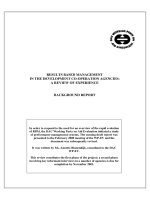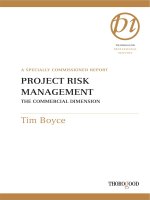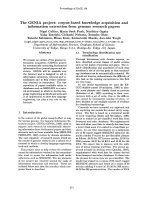The hanbook project based management
Bạn đang xem bản rút gọn của tài liệu. Xem và tải ngay bản đầy đủ của tài liệu tại đây (2.33 MB, 473 trang )
THE HANDBOOK OF
PROJECT-BASED
MANAGEMENT
Other books by Rodney Turner published by McGraw-Hill
Turner, J.R., Grude, K.V. and Thurloway, L., 1996, (eds), The Project Manager as Change Agent,
McGraw-Hill, London, 264p, ISBN: 0-07-707741-5.
Turner, J.R., (ed), 1995, The Commercial Project Manager, McGraw-Hill, London, 408 p, ISBN:
0-07-707946-9.
THE HANDBOOK OF
PROJECT-BASED
MANAGEMENT
Leading Strategic Change in Organizations
J. Rodney Turner
Third Edition
New York Chicago San Francisco Lisbon London Madrid
Mexico City Milan New Delhi San Juan Seoul
Singapore Sydney Toronto
Copyright © 2009, 1999, 1993 by The McGraw-Hill Companies, Inc. All rights reserved. Except as
permitted under the United States Copyright Act of 1976, no part of this publication may be reproduced or distributed in any form or by any means, or stored in a database or retrieval system, without
the prior written permission of the publisher.
ISBN: 978-0-07-154975-2
MHID: 0-07-154975-7
The material in this eBook also appears in the print version of this title: ISBN: 978-0-07-154974-5,
MHID: 0-07-154974-9
All trademarks are trademarks of their respective owners. Rather than put a trademark symbol after
every occurrence of a trademarked name, we use names in an editorial fashion only, and to the benefit of the trademark owner, with no intention of infringement of the trademark. Where such designations appear in this book, they have been printed with initial caps.
McGraw-Hill eBooks are available at special quantity discounts to use as premiums and sales promotions, or for usein corporate training programs. To contact a representative please visit the Contact Us
page at www.mhprofessional.com.
Information contained in this work has been obtained by The McGraw-Hill Companies, Inc.
(“McGraw-Hill”) from sources believed to be reliable. However, neither McGraw-Hill nor its authors
guarantee the accuracy or completeness of any information published herein, and neither McGrawHill nor its authors shall be responsible for any errors, omissions, or damages arising out of use of this
information. This work is published with the understanding that McGraw-Hill and its authors are supplying information but are not attempting to render engineering or other professional services. If such
services are required, the assistance of an appropriate professional should be sought.
TERMS OF USE
This is a copyrighted work and The McGraw-Hill Companies, Inc. (“McGraw-Hill”) and its licensors
reserve all rights in and to the work. Use of this work is subject to these terms. Except as permitted
under the Copyright Act of 1976 and the right to store and retrieve one copy of the work, you may not
decompile, disassemble, reverse engineer, reproduce, modify, create derivative works based upon,
transmit, distribute, disseminate, sell, publish or sublicense the work or any part of it without
McGraw-Hill’s prior consent. You may use the work for your own noncommercial and personal use;
any other use of the work is strictly prohibited. Your right to use the work may be terminated if you
fail to comply with these terms.
THE WORK IS PROVIDED “AS IS.” McGRAW-HILL AND ITS LICENSORS MAKE NO GUARANTEES OR WARRANTIES AS TO THE ACCURACY, ADEQUACY OR COMPLETENESS OF
OR RESULTS TO BE OBTAINED FROM USING THE WORK, INCLUDING ANY INFORMATION THAT CAN BE ACCESSED THROUGH THE WORK VIA HYPERLINK OR OTHERWISE,
AND EXPRESSLY DISCLAIM ANY WARRANTY, EXPRESS OR IMPLIED, INCLUDING BUT
NOT LIMITED TO IMPLIED WARRANTIES OF MERCHANTABILITY OR FITNESS FOR A
PARTICULAR PURPOSE. McGraw-Hill and its licensors do not warrant or guarantee that the
functions contained in the work will meet your requirements or that its operation will be uninterrupted or error free. Neither McGraw-Hill nor its licensors shall be liable to you or anyone else for any
inaccuracy, error or omission, regardless of cause, in the work or for any damages resulting therefrom.
McGraw-Hill has no responsibility for the content of any information accessed through the work.
Under no circumstances shall McGraw-Hill and/or its licensors be liable for any indirect, incidental,
special, punitive, consequential or similar damages that result from the use of or inability to use the
work, even if any of them has been advised of the possibility of such damages. This limitation of
liability shall apply to any claim or cause whatsoever whether such claim or cause arises in contract,
tort or otherwise.
To Edward, now 18
This page intentionally left blank
ABOUT THE AUTHOR
RODNEY TURNER is Professor of Project Management at the Kemmy Business School of the
University of Limerick and at the Lille School of Management. He is also an Adjunct
Professor at the University of Technology, Sydney and Educatis University, Zurich, and was
a Visiting Professor at Henley Management College and George Washington University.
Rodney Turner is the author or editor of fourteen books. He is editor of The International
Journal of Project Management, and has written articles for journals, conferences, and
magazines. He lectures on and teaches project management worldwide.
From 1991 to 2004, Rodney was a member of Council of the UK’s Association for Project
Management, with two years as Treasurer and two as Chairman. He is now a Vice President.
From 1999 to 2002, he was President and then Chairman of the International Project
Management Association, the global federation of national associations in project management, of which APM is the largest member. He has also helped to establish the Benelux
Region of the European Construction Institute as foundation Operations Director. Rodney is
director of several SMEs and a member of the Institute of Directors. He is also a Fellow of
the Institution of Mechanical Engineers and of the Association for Project Management.
This page intentionally left blank
CONTENTS
Preface
xv
Acknowledgments
xvii
Chapter 1: Leading Change through Projects
1.1
1.2
1.3
1.4
1
Projects and their Management / 2
The Process Approach / 17
The Management of Projects and this Book / 20
Images of Projects / 21
Summary / 24
References / 25
Part 1: Managing the Context
Chapter 2: Projects for Delivering Beneficial Change
2.1
2.2
2.3
2.4
Identifying the Need for Performance Improvement / 29
Diagnosing the Change Required / 31
The Benefits Map / 37
Projects for Implementing Corporate Strategy / 39
Summary / 46
References / 46
Chapter 3: Project Success and Strategy
3.1
3.2
3.3
3.4
3.5
47
Project Success Criteria / 48
Key Performance Indicators / 52
Project Success Factors / 53
The Strategic Management of Projects / 60
Principles of Project Management / 65
Summary / 67
References / 68
Chapter 4: The People Involved
4.1
4.2
4.3
4.4
29
Reactions to Change / 71
Managing Stakeholders / 77
Communicating with Stakeholders
Project Teams / 85
71
/ 83
ix
x
CONTENTS
4.5 Leading Projects / 89
Summary / 95
References / 96
Part 2: Managing Performance
Chapter 5: Managing Scope
5.1
5.2
5.3
5.4
5.5
Principles of Scope Management / 102
Project Definition / 104
Planning at the Strategic Level: Milestone Plans
Planning at Lower Levels / 113
Applications / 118
Summary / 120
References / 121
101
/ 106
Chapter 6: Managing Project Organization
6.1
6.2
6.3
6.4
123
Principles / 123
The External Organization / 126
The Internal Organization / 131
Responsibility Charts / 133
Summary / 139
References / 140
Chapter 7: Managing Quality
141
7.1 Quality in the Context of Projects / 141
7.2 Achieving Quality on Projects / 144
7.3 Configuration Management / 148
Summary / 154
References / 155
Chapter 8: Managing Cost
8.1
8.2
8.3
8.4
Estimating Costs / 157
Types of Costs / 162
Estimating Techniques / 171
Controlling Costs: Obtaining Value for Money /
Summary / 181
References / 182
157
175
Chapter 9: Managing Time
9.1
9.2
9.3
9.4
9.5
The Time Schedule / 183
Estimating Duration / 189
Calculating the Schedule with Networks / 191
Resource Histograms and Resource Smoothing /
Controlling Time / 204
Summary / 207
References / 208
183
201
CONTENTS
Chapter 10: Managing Risk
10.1
10.2
10.3
10.4
10.5
xi
209
The Risk Management Process / 209
Identifying Risk / 211
Assessing Risk / 216
Analyzing Risk / 223
Managing Risk / 226
Summary / 230
References / 231
Part 3: Managing the Process
Chapter 11: The Project Process
11.1
11.2
11.3
11.4
11.5
11.6
235
The Project and Product Life Cycle / 235
The Feasibility Study / 239
The Design Phase / 242
New Product Development / 246
Concurrent Engineering / 250
Information Systems Projects / 254
Summary / 262
References / 263
Chapter 12: Project Start-Up
265
12.1 The Start-Up Process / 265
12.2 Start-Up Workshops / 270
12.3 Project Definition Report and Manual / 274
Summary / 277
References / 278
Chapter 13: Project Execution and Control
13.1
13.2
13.3
13.4
13.5
13.6
Resourcing a Project / 279
Implementation Planning / 280
Allocating Work / 284
Requirements for Effective Control / 286
Gathering Data and Calculating Progress / 288
Taking Action / 294
Summary / 296
References / 298
Chapter 14: Project Close Out
14.1
14.2
14.3
14.4
14.5
279
Timely and Efficient Completion / 300
Transferring the Asset to the Users / 301
Embedding the Change and Obtaining Benefit
Disbanding the Team / 303
Postcompletion Reviews / 305
Summary / 306
References / 307
299
/ 302
xii
CONTENTS
Part 4: Governance of Project-Based Management
Chapter 15: Project Governance
15.1
15.2
15.3
15.4
311
Governance / 311
Governance of the Project / 312
The Principal-Agent Relationship / 315
Communication between the Project Manager and Sponsor /
Summary / 320
References / 321
317
Chapter 16: Program and Portfolio Management
16.1
16.2
16.3
16.4
Definitions / 324
Managing Portfolios / 328
Managing Programs / 335
The Project Office / 337
Summary / 340
References / 341
Chapter 17: Developing Organizational Capability
17.1
17.2
17.3
17.4
17.5
17.6
343
Defining Capability / 343
Developing Individual Competence / 345
Developing Organizational Capability / 350
Improving Organizational Capability / 359
Knowledge Management / 361
Competency Traps / 362
Summary / 364
References / 365
Chapter 18: Governance of the Project-Based Organization
18.1
18.2
18.3
18.4
323
Governance of Project Management /
Conducting Audits / 371
Conducting Health Checks / 375
End-of-Stage Reviews / 383
Summary / 388
References / 389
367
367
Chapter 19: International Projects
391
19.1 Types of International Project / 391
19.2 The Problem of International Projects / 394
19.3 Managing Culture / 397
Summary / 406
References / 407
Chapter 20: Epilogue
20.1 Principles of Project Management / 409
20.2 Key Success Factors / 410
409
CONTENTS
xiii
Appendix A: Project Definition Report for the CRMO
Rationalization Project
413
Appendix B: Project Control Documents for the CRMO
Rationalization Project
427
Subject Index 437
Author and Source Index
Project Index 451
447
This page intentionally left blank
PREFACE
One of my aims in writing successive editions of this book has been to maintain the book’s
length. That means that as I include new ideas, I have to drop some material. I don’t want
a book that gets fatter and fatter to the point where I have to start dividing it into two or
more separate books. Project management is a dynamic and developing topic, and that
means that there are new ideas that need to be included in the book. But also some ideas
that were included in the first and second edition are now past their sell-by date and so can
be dropped. I have aimed to produce a book that covers the key topics of project management as people see it at the moment, and to leave out some of the concepts that have not
proved so effective.
The book is one part shorter than the previous edition, at four parts rather than five. The
first three parts cover the same ground as the first three parts of the previous two editions.
Part 1 describes the context of projects. In particular it considers how the strategy of
the parent organization and the desire to achieve performance improvement through
strategic change drive the creation of projects. It then looks at project success strategy and
describes the criteria by which we judge success, the factors by which we increase the
chance of success, and how we combine the two into a strategy for our projects. The third
chapter in the part considers the people involved in the project. It takes a different perspective from the previous two editions where the equivalent chapter looked at the position of projects in the parent organization. In this edition that chapter focuses much more
on how to lead the stakeholders to gain their support for the project.
Part 2 covers the same ground as the previous two editions, describing the functions of
project management, how to manage the scope, project organization, quality, cost, time,
and the risk that pervades them all.
Part 3 also substantially covers the same ground as the previous editions, describing
three stages of the project life cycle: start, execution, and close-out. However, I have
included a new chapter at the start of the part, describing the project life cycle, and different versions for different types of project. This chapter covers much of the ground of what
was previously the fifth part, on applications, but in a more focused way.
Although these three parts cover very much the same ground, I have incorporated new
thinking, and so in places the material is different from the previous editions.
It is in Part 4 where I have taken a radically different approach. In the previous two editions, Part 4 described administrative support given to the project by the parent organization. Now, in accordance with the modern style, I take a governance perspective. As a result,
it covers some of the same ground, because the administrative support described in the previous editions is governance support, but it also introduces many new ideas. I start by defining what we mean by governance and describe the governance of the individual project, and
the governance roles that imply. In the next two chapters, I describe the governance of the
context, particularly program and portfolio management and the development of organizational project management capability. I then describe the project governance role of the
executive board, and the interest they should take in projects.
xv
xvi
PREFACE
I have retained the chapter on international projects as the last main chapter, and as in
the previous two editions close with an epilogue.
I have updated the references throughout the book. I think the main purpose of references is to point to further reading for readers who want to find out more about the topics.
I think that only books that are readily available are useful for the purpose, so I tend not to
cite academic research journals or magazine articles for that purpose, and definitely not
obscure conferences. The other main purpose for references is to acknowledge source
materials, and for that purpose I may cite an academic research journal article.
Rodney Turner
East Horsley, Surrey
ACKNOWLEDGMENTS
My main thanks in writing this third edition continues to go to the now nearly 30,000 people
who have bought the previous editions, and thereby give me encouragement to continue
to spread the good word of project management. I would also like to thank Wade Ren and
Vladimir Voropayev who led the translation of the book into Chinese and Russian, respectively.
I wish to thank the people with whom I have worked and whose ideas have contributed
to the material of this book. The first and second editions drew on distance learning material in project management at Henley Management College. Elements of the third edition still
draw on the ideas of Mahen Tampoe, Susan Foreman, Svine-Arne Jessen, Peter Morris, Nick
Aked, Roger Sharp, Richard Morreale, David Topping, and Anne French. There are also
people with whom I have written research papers over the years, particularly Bob Cochrane,
Anne Keegan, Martina Huemann, and Ralf Müller. I also wish to acknowledge the ongoing
inspiration I receive from my work with Kristofer Grude, with whom I wrote my first book
over 20 years ago.
I have received significant help in the process of writing the book from Judy Morton.
Judy has proofread all the material, and helped me prepare the figures.
And finally, I must thank my family for putting up with all the travel that spreading the
good word of project management seems to entail.
Rodney Turner
East Horsley, Surrey
xvii
This page intentionally left blank
THE HANDBOOK OF
PROJECT-BASED
MANAGEMENT
This page intentionally left blank
CHAPTER 1
LEADING CHANGE THROUGH
PROJECTS
Change, and the need to manage change through projects, touches all our lives, in working
and social environments. Twenty years ago most managers were not directly involved in the
management of projects. Bureaucracies were viewed as providing an efficient, stable, and
certain environment in which to conduct business. Change was mistrusted. Managing change
was limited to specialist, technical functions. That has now changed. Change is endemic,
brought on by an explosion in the development of technology and communications. Rather
than being the preferred style of management, bureaucracies are viewed as restricting an organization’s ability to respond to change, and thereby maintain a competitive edge.
The last 50 years has characterized this changing emphasis. The 1960s were a decade
of mass production. Manufacturing companies strove to increase output. Production methods were introduced to facilitate that. High production rates were achieved, but at the
expense of quality. During the 1970s, to differentiate themselves companies strove for
quality. By imposing uniformity and restricting their product range, managers could
achieve quality while maintaining high production. In the 1980s, the emphasis shifted to
variety. Customers wanted their purchases to be different from their neighbours’. No two
motor cars coming off the production line were the same, and nonsmokers would rather
have a coin tray in place of the ashtray. Companies introduced flexible manufacturing systems to provide variety, while maintaining quality and high production. In the 1990s, customers wanted novelty. No one buying a new product wanted last year’s model. Product
development times and market windows shrank, requiring new products to be introduced
quickly and effectively. Now customers want functionality. They don’t just want their cell
phones to make telephone calls; they want to send text messages and e-mails, surf the
Internet, take photographs, and store their music library. (My son Edward describes products with excessive functionality as being Gucci.) Organizations must adopt flexible structures to respond to the changing environment. To gain competitive advantage, they need to
be in a constant state of flux to improve their business processes. Many clients expect every
product to be made to a bespoke design, and so every product becomes a mini project.
The project-oriented organization is now common; project-based management is the
new general management1; 30 percent of the global economy is project-based.2 Project
management is a skill required of all managers. This book provides general managers in
project-oriented companies with a structured approach to the management of projects, so
they can achieve performance improvement through the management of change.
In this chapter, I describe the structured approach and its three dimensions: the project,
the process of managing the project, and the levels over which it is managed. I then explain
the importance of the process approach and introduce a model for the strategic management
of projects. Next, I cover two issues, one dealing with the nature of projects, and one the
1
2
LEADING CHANGE THROUGH PROJECTS
nature of project management. The first is a classification of projects based on how well
defined the project’s goals are and the methods of achieving those goals, which influences
the choice of strategy for managing the project. The second is an analogy of project management as sailing a yacht, which challenges traditional concepts of management. I end the
chapter by explaining the overall structure of the book.
1.1 PROJECTS AND THEIR MANAGEMENT
Projects come in many guises. There are traditional major projects from heavy engineering, or WETT, industries, (water, energy, transport, telecommunications). These are significant endeavours involving large dedicated teams, often requiring the collaboration of
several sponsoring organizations. But the projects with which most of us are involved are
smaller. Projects at work include engineering or construction projects to build new facilities;
maintenance of existing facilities; implementation of new technologies or computer systems; research, development, and product launches; or management development or training programs. Projects from our social lives include moving to a new house; organizing
the local church fête; or going on holiday. So what do we understand by projects and project
management?
Project management is about converting vision into reality. We have a vision of some
future state we would like to achieve. It may be a new computer system, a new production
process, a new product, a new organization structure, or more competent managers. We
foresee that the operation of that new state will help us improve performance of our business, by solving a problem or exploiting an opportunity, and so provide us with benefit that
will repay the cost of achieving it. Project-based management is the structured process by
which we successfully deliver that future state (I discuss in a later chapter what is understood by “successfully”). In this section I define what I mean by projects and their management, and describe the three key components of project-based management: the project,
the management of the project, and the levels over which they are managed.
The Project
Previously, I used the following definition of a project:
A project is an endeavour in which human, financial, and material resources are organized
in a novel way to undertake a unique scope of work, of given specification, within constraints
of cost and time, so as to achieve beneficial change defined by quantitative and qualitative
objectives.
One of my former MBA students objected to this definition (see Example 1.1).
Although I think he was missing the point, his objection had some validity in that this definition is rather prescriptive, and unnecessarily so. Now I have chosen to adopt a less prescriptive definition which focuses on the key features (Fig. 1.1):
A project is a temporary organization to which resources are assigned to do work to deliver
beneficial change.
Example 1.1 Maintenance “projects” in BT
I had an MBA student who took exception to my definition. He worked on projects, he
said, that were repetitive, and neither unique nor novel. They were maintenance projects in
LEADING CHANGE THROUGH PROJECTS
3
Exploitation
Improved
performance
Goals
Benefit
Outcomes
Operation
Resources
Project
Outputs
Implementation
FIGURE 1.1 The definition of a project.
British Telecom. He said my definition was wrong; he did not have the humility to see
that his application of the word “project” might be wrong. But of course that was not the
point; his maintenance projects had some features of projects and some of routine operations, and therefore needed a hybrid management approach. He found some value from
looking on his work as projects, but he did not see that the purpose of a definition is to
aid understanding, not to be precise and prescriptive.
A Temporary Organization. A project is a temporary organization. We have a vision of
a future state we wish to achieve, and we need resources to do work to deliver it. So we create a new organization within which those resources can work. That organization will have
only a temporary existence, being disbanded when the new state is achieved. For me the
concept of the project as a temporary organization in which we assemble resources to do
the work to achieve our desired future state is key. Many people define a project as a temporary task, or temporary endeavour (for example, see the PMI® PMBoK®3). I do like to
differentiate between a temporary task given to the routine organization and a temporary
organization specifically created to deliver the project. I would not describe the maintenance tasks in Example 1.1 as projects; they are temporary tasks undertaken by the routine
organization. (If someone finds value in labelling what they do as a project I would encourage them to do so, but I would also advise not to label things as projects when more routine
management approaches may be more appropriate for their delivery.)
How temporary is temporary? All organizations are permanent on some time scales and
temporary on others. The oldest organization I know about is the Church of Rome, which
is 2000 years old. The longest project I am aware of from first work to eventual completion
is the Rhine to Danube Canal. The first work was done by Charlemagne about 792 and it
was completed 1200 years later in 1992. Fortune 500 companies have an average life of
50 years, and so are temporary on that timescale. Permanent and temporary are social constructs. The parent organization views itself as permanent, and creates a project that it
expects to have shorter existence to achieve specific objectives.
Carroll4 suggests that the success of an organization form depends on its ability to attract
resources. Projects as an organizational form are very effective at attracting resources
because they are an effective way of managing change. They can deliver change in a fast
and flexible way, in ways that cannot be achieved in the routine organization. They can also
be used to prototype new ways of working. Carroll also suggests that an organization’s
longevity is an indication of its efficiency. Projects are effective at delivering change, but
an inefficient way of working, so as soon as the change is delivered the project should be
4
LEADING CHANGE THROUGH PROJECTS
disbanded and routine management adopted to manage the new asset delivered. I use the
analogy of comparing a supertanker to a flotilla of yachts: A routine organization is like a
supertanker—a very efficient way of transporting crude oil around the world, but it takes
three miles to turn. A flotilla of yachts can turn on the spot and achieve things a supertanker
cannot achieve, but it is an inefficient way of transporting goods in bulk. We return to this
analogy later in the chapter.
The Resources and the Work. We assemble the resources of the project to do work. The
resources (per my old definition) can be people, materials, or money, or all three.
The work of the project has three features: it is unique, novel, and transient (Table 1.1).
The project has a transient existence and is disbanded when the work to deliver the new
asset is finished. Thus we expect the work to be transient. We may never have built an asset
like this before—the project is unique—and so we need to adopt novel work processes. It
annoys me when project managers try to grab the moral high ground by saying projects are
about delivering objectives within constraints of time, cost, and quality. All of business—
all of life—is about trying to deliver objectives within constraints of time, cost, and quality. By trying to grab the moral high ground in this way project managers do themselves no
favors because they fail to focus on what is special about their discipline, the uniqueness,
novelty, transience, and implied risk. In business there are repeat objectives, which require
us to do repetitive things, and there are new objectives which require us to do unique, novel,
and transient things. With the latter, it is more difficult to achieve the constraints of time,
cost, and quality, because there is less previous experience on which to base our plans, and
therefore greater risk of failure.
TABLE 1.1 The Features of a Project
Goal
Unitary
Beneficial
Change
Features
Pressures
The Plan
Unique
Novel
Transient
Uncertainty
Integration
Urgency
Flexible
Goal oriented
Staged
What do we mean by unique and novel? The student in Example 1.1 thought his projects were very repetitive. There is a way of categorizing projects, into runners, repeaters,
strangers, and aliens that recognizes that projects range from the familiar to the unknown:
Runners: These are very familiar. They almost count as batch processing. The projects
in Example 1.1 (if they are projects) would fall in this category. Routine processes can
be used.
Repeaters: These are fairly familiar. There is knowledge in the organization about how
they should be managed, on which the project team can draw during the project start-up
process.
Strangers: The organization has undertaken similar projects in the past but there are
unfamiliar elements. I would classify the construction of the Channel tunnel as this type
of project: it wasn’t the first undersea tunnel ever built; it wasn’t the first time a high
speed railway line had been put in a tunnel; but it was the first time that such a tunnel
had been built between England and France. There were many familiar elements to
draw on but the overall project was completely novel.









